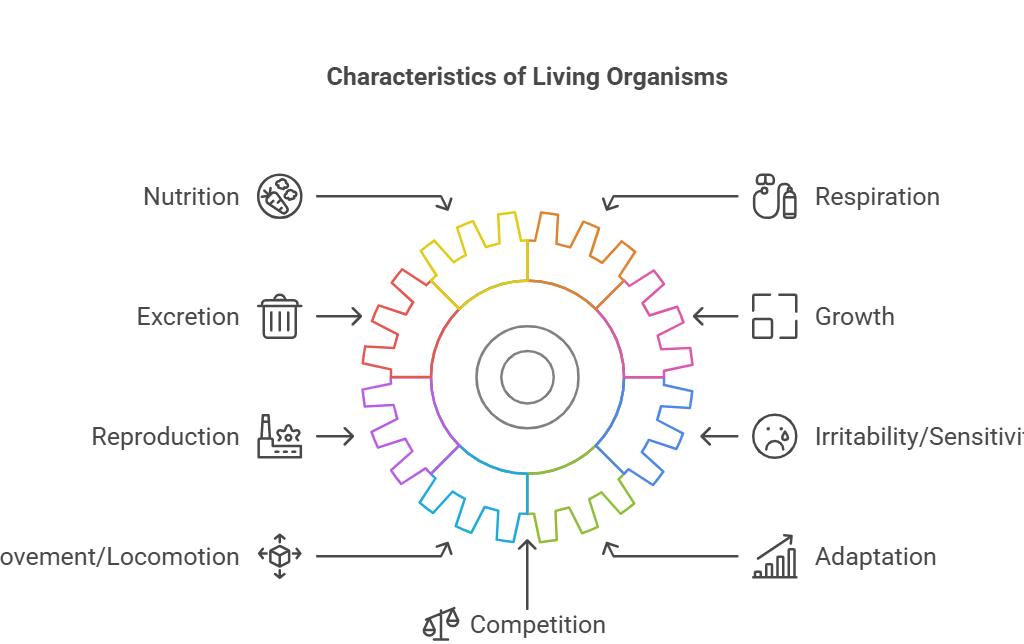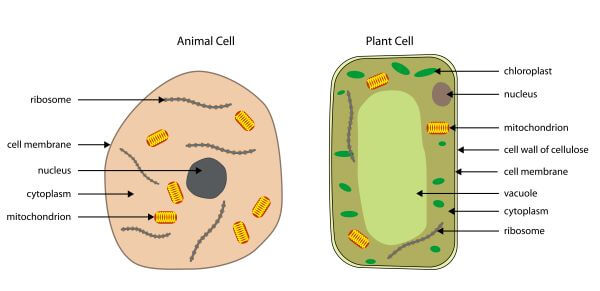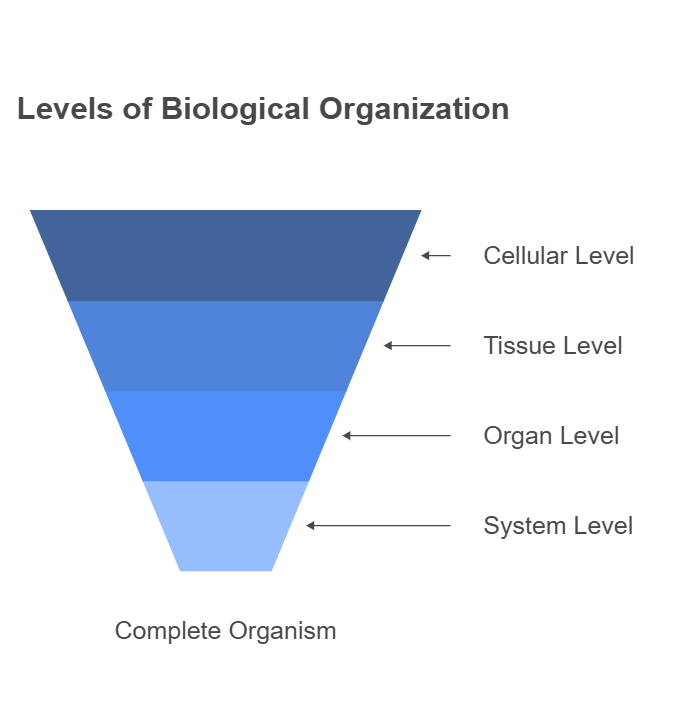JAMB Biology Notes-Living Organisms
Topic
Living Organisms
Sub-Topics
- Characteristics of Living Organisms
- Cell Structure and Functions of Cell Components
- Levels of Organization in Living Organisms (Cell → Tissue → Organ → System → Organism)
Table of Contents
- Topic
- Sub-Topics
- 1. Characteristics of Living Organisms
- 2. Cell Structure and Functions of Cell Components
- 3. Levels of Organization in Living Organisms
- SUMMARY/REINFORCEMENT
- ASSIGNMENT
1. Characteristics of Living Organisms
- Nutrition: The process by which organisms obtain and utilize food for growth, energy, and maintenance.
- Respiration: The breakdown of food (often glucose) to release energy. Aerobic respiration uses oxygen; anaerobic respiration does not.
- Excretion: The removal of metabolic waste products such as carbon dioxide, urea, and excess water from the body.
- Growth: An irreversible increase in size and/or complexity of an organism. It usually involves cell division (mitosis) and cell enlargement.
- Reproduction: The ability to produce offspring of the same kind, either sexually or asexually.
- Irritability/Sensitivity: The ability to perceive and respond to stimuli from the environment (e.g., light, temperature, touch).
- Movement/Locomotion: A change in position. Animals usually move from place to place; plants show movement in parts (e.g., bending toward light).
- Adaptation: Traits that increase an organism’s chance of survival and reproduction in a specific environment.
- Competition: Living organisms often compete for resources such as food, space, water, and mates.

Distinguishing Living from Non-living Things
- Living things exhibit all or most of the above characteristics.
- Non-living things do not perform these life processes and are incapable of self-sustaining activity.
2. Cell Structure and Functions of Cell Components
Definition of a Cell
- The cell is the basic structural and functional unit of life. Every living organism is made up of one or more cells.
Types of Cells
- Plant Cells
- Animal Cells

Basic Cell Components (Common to Plant & Animal Cells)
- Cell Membrane (Plasma Membrane)
- Selectively permeable membrane that regulates the movement of substances into and out of the cell.
- Cytoplasm
- Jelly-like fluid that holds cell organelles. It is the site of many metabolic processes.
- Nucleus
- Controls cell activities and contains genetic material (DNA).
- Mitochondrion (plural: Mitochondria)
- Responsible for energy (ATP) production through aerobic respiration.
- Ribosomes
- Sites of protein synthesis; can be found on the endoplasmic reticulum or free in the cytoplasm.
- Endoplasmic Reticulum (ER)
- Rough ER has ribosomes for protein synthesis; Smooth ER is involved in lipid synthesis and detoxification.
- Golgi Body (Golgi Apparatus)
- Modifies, sorts, and packages proteins and lipids for storage or transport out of the cell.
Additional Organelles Unique to Plant Cells
- Cell Wall
- Made of cellulose; provides rigid support and protection.
- Chloroplasts
- Contain chlorophyll for photosynthesis.
- Large Central Vacuole
- Maintains turgor pressure to support the plant cell; stores nutrients and wastes.
Comparing Plant and Animal Cells
| Feature | Plant Cell | Animal Cell |
|---|---|---|
| Cell Wall | Present (cellulose) | Absent |
| Chloroplast | Present (in photosynthetic tissues) | Absent |
| Shape | Generally fixed/regular (rectangular) | Irregular (varied shapes) |
| Vacuole | Large, central vacuole | Small, often numerous vacuoles (if any) |
| Centrioles | Absent in most plants | Present in animal cells |
| Energy Storage | Starch | Glycogen |
| Location of Nucleus | Usually pushed to the periphery by large vacuole | Centrally located |
3. Levels of Organization in Living Organisms

- Cell
- The simplest unit of life.
- Examples: Euglena, Paramecium, Chlamydomonas (these are unicellular organisms).
- Tissue
- A group of similar cells performing a specific function.
- Examples: Epithelial tissues in animals, Hydra (which exists as a tissue-level organism).
- Organ
- A structure composed of different tissues working together for a specific function.
- Example: Onion bulb (in plants), stomach (in animals).
- System
- A group of organs working together to carry out an overall life function.
- Examples: Reproductive system, digestive system, excretory system (in animals).
- Organism
- A complete living thing that can carry out all basic life processes independently.
- Single-celled organisms like Chlamydomonas or complex multicellular organisms like humans.
Logical Sequence
Cell → Tissue → Organ → System → Organism
SUMMARY/REINFORCEMENT
- Living organisms are defined and differentiated by key life processes: nutrition, respiration, excretion, growth, reproduction, irritability, and movement.
- Cells are the basic units of life and are broadly categorized into plant and animal cells with some distinct structural differences (e.g., cell wall, chloroplasts).
- Levels of organization move in sequence from cells to tissues, then organs, systems, and finally the whole organism. Examples like Euglena, Hydra, and onion bulb highlight these levels.
ASSIGNMENT
- Define the term cell and list three major differences between a plant cell and an animal cell.
- Explain why Euglena is considered a unicellular organism and describe two features it shares with higher plants or animals.
- Arrange the following in ascending order and briefly explain each: organ, cell, organism, system, tissue.
- State any four characteristics of living things and provide one example each (plants or animals) to illustrate them.





